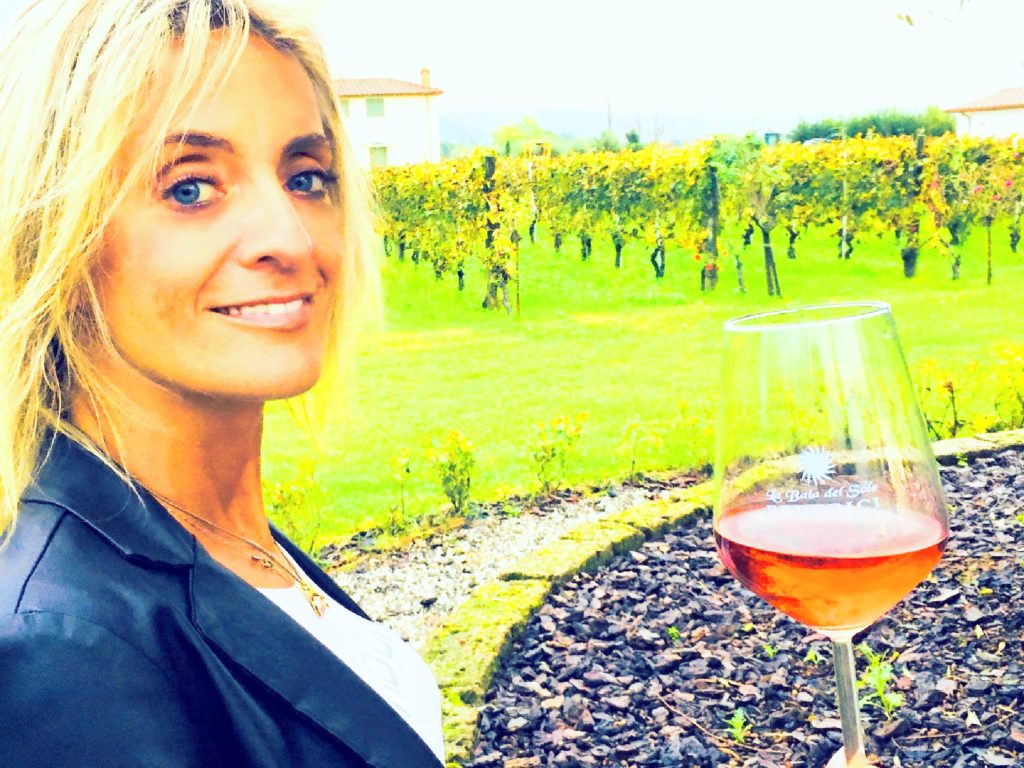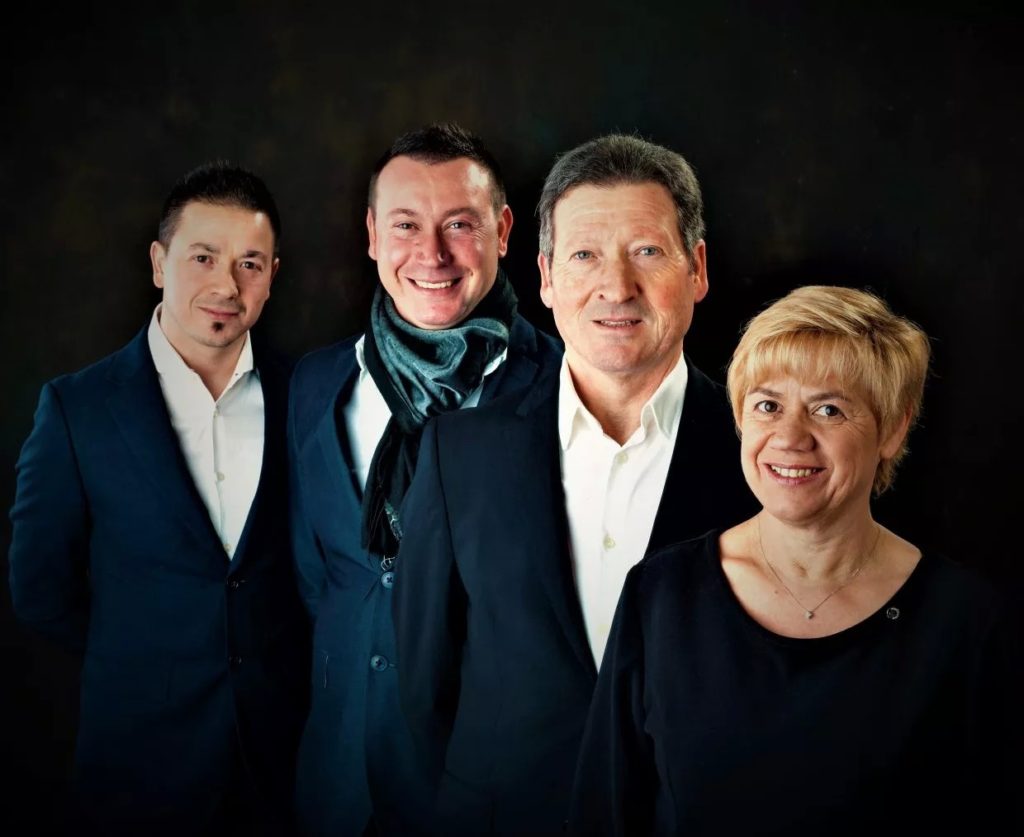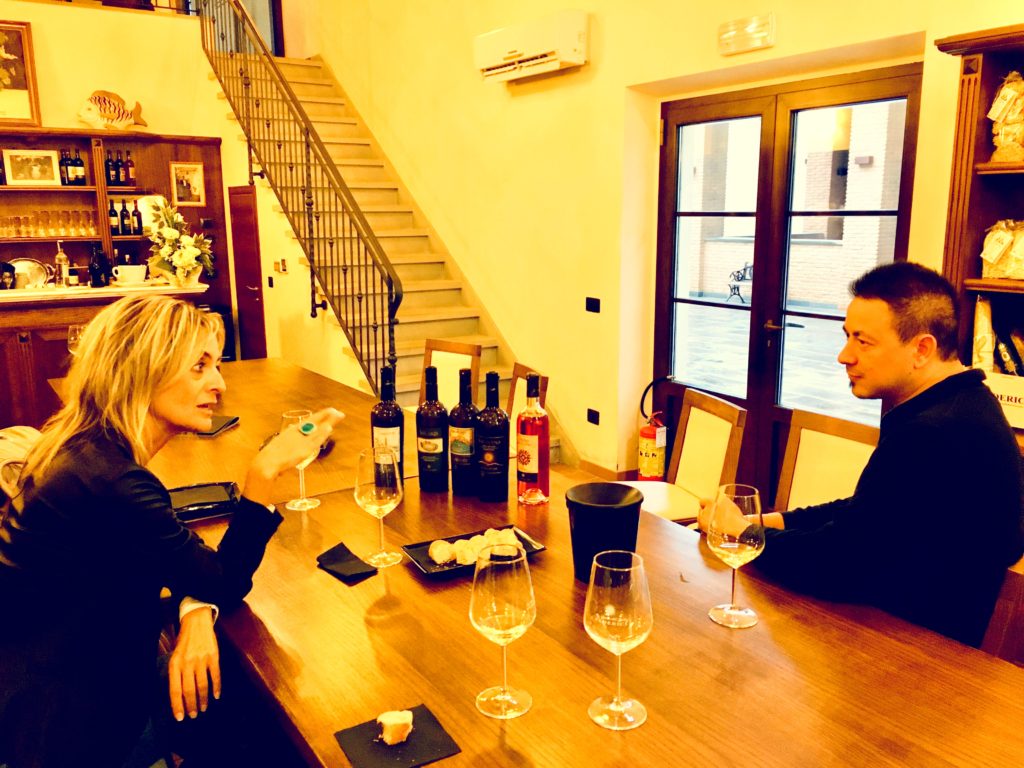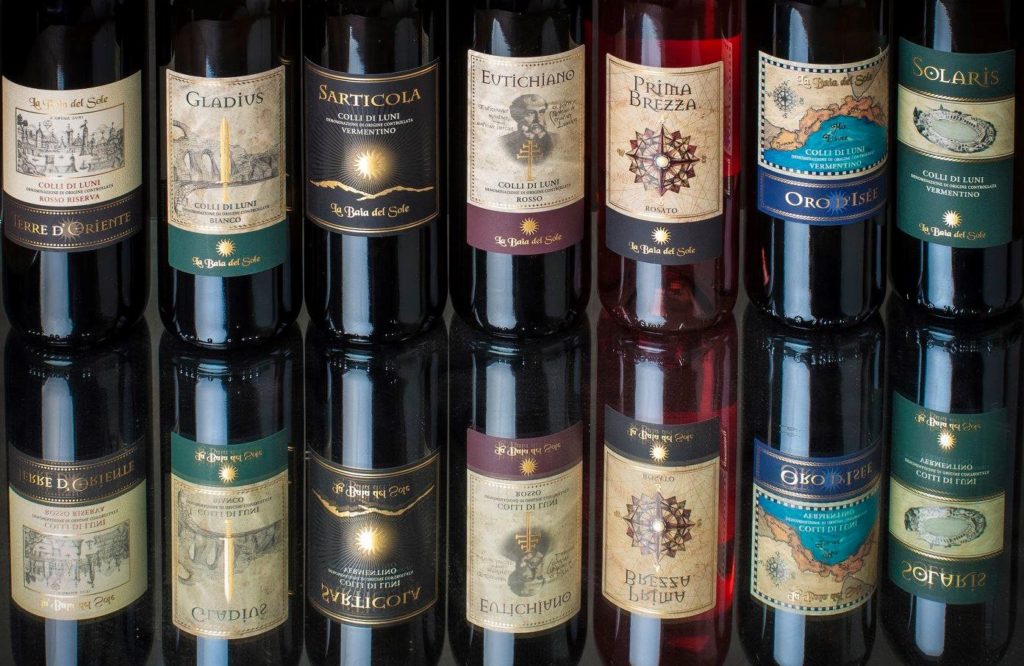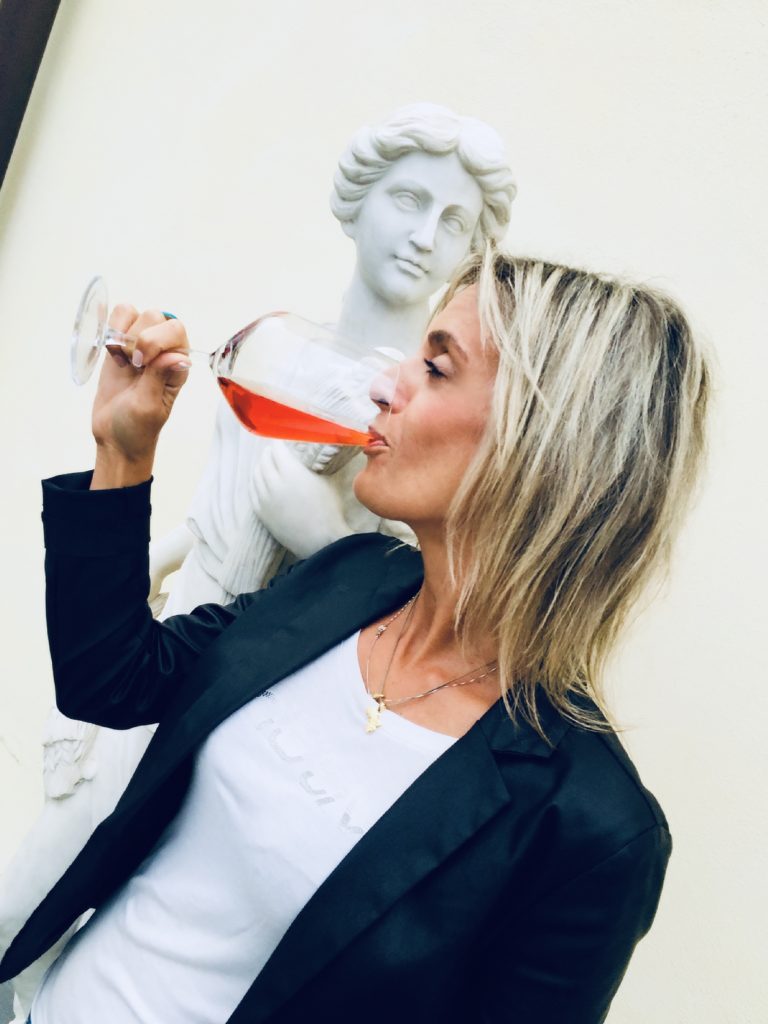“Chi non ama le donne, il vino e il canto è solo un matto , non un santo”.
‘Cantina Villa Santo Stefano’, Lucca
‘Cantina Villa Santo Stefano’ è un’ azienda agricola di lusso, che definirei quasi surreale per la sua bellezza. Essa sta nascosta , ma ancora per poco, tra le magnifiche e dolci colline lucchesi di Pieve di Santo Stefano. Claudia Martinelli, responsabile della società di marketing ‘Darwin & Food’ , mi inivita a una degustazione dei loro superbi vini.
‘Cantina Villa Santo Stefano’ è un pò difficile da trovare, almeno per me , specie sotto un sole cocente , quello tipico di una mattina di luglio . Mi smarrisco in macchina per delle stradine strette in direzione Pieve di Santo Stefano . Tuttavia non mi scoraggio . Dopo un’oretta da Pisa raggiungo la loro sede in via della Chiesa 504 B . L’emozione di ritrovarmi con altri giornalisti e blogger per questo evento straordinario è infinita. Seguitemi per sapere di cosa si tratta!
Wolfgang Reitzle e Nina Ruge
Arrivata a ‘Cantina Villa Santo Stefano’ i gestori ci accolgono con un sorriso enorme . Inizialmente facciamo un giro dentro il parco enorme. Questo è immerso in una natura ordinata e rigogliosa. Accanto la piscina c’è l’ingresso per la sala degustazione. Dopo avere varcato delle grandi porte in ferro battut, ci mettiamo comodi sulle sedie. Tutto lo staff della stampa è incantato dalla raffinatezza degli interni e dell’apparecchiatura della tavola, imbandita con posate d’argento.
‘Cantina Villa Santo Stefano’ vuol dire anche un serivzio eccellente ! Appena i camerieri servono i vari bianchi e rossi aziendali, stiamo fermi e immobili ad ascoltare la storia della tenuta attraverso le parole dell’ ingegnere tedesco Wolfgang Reitzle. Lui ne è il fondatore insieme alla moglie Nina Ruge, famosa giornalista e presentatrice alemanna. Ciò che mi stupisce è soprattutto l’ ottimo rapporto qualità prezzo dei loro prodotti enoici, che esprimono al meglio lo splendore lo spirito della Toscana.
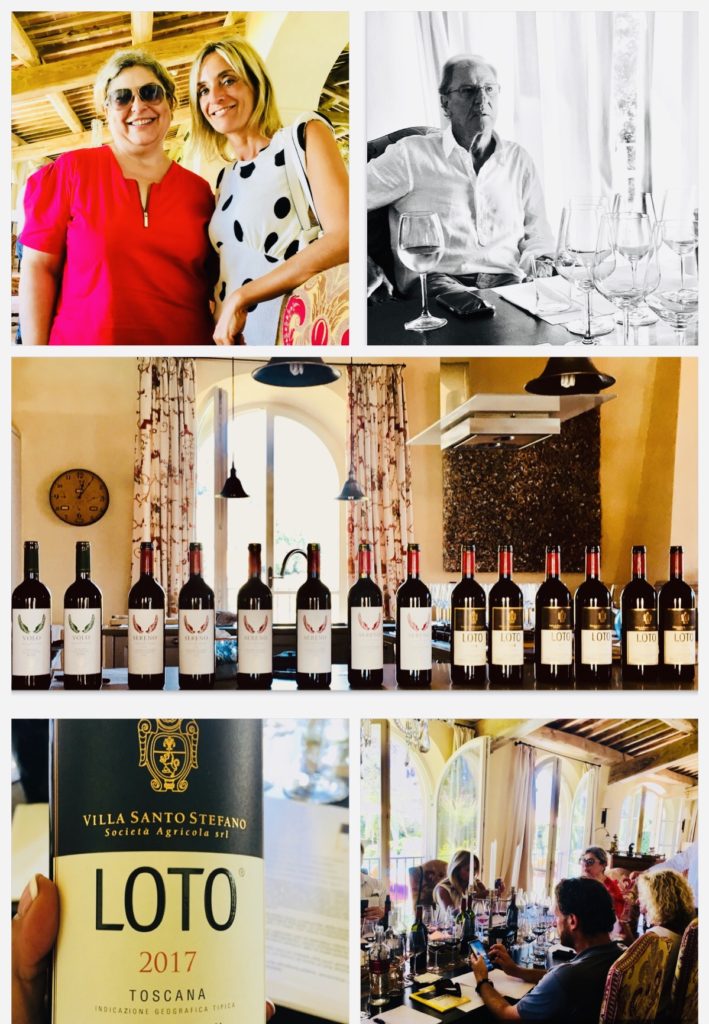
Il sogno diventato realtà di Wolfgang Reitzle
Wolfgang Reitzle è il proprietario di ‘Cantina Villa Santo Stefano’ . Questi è un signore alto , distinto , di una classe innata. Lui è felice di parlare di come nel tempo è riuscito a trasformare la sua passione per il vino in un lavoro, che adesso si è materializzato in ‘Cantina Villa Santo Stefano’ .
Wolfgang Reitzle, ex dirigente della ‘BMW’ e poi CEO della ‘Ford’, ci spiega che tutto è nato quasi per caso. Sin da piccolo l’imprenditore tedesco si reca frequentemente in Toscana per le vacanze con la sua famiglia. Da allora il desiderio di viverci è forte. A tal punto che poi , nel corso della sua vita , decide di acquistare un fazzoletta di terra nella regione più amata d’Italia.
Come nasce la ‘Cantina Villa Santo Stefano’ ?
Wolfgang Reitzle vuole creare così un posto dove coltivare la vite e produrre nettari divini fatti di vitigni locali come:
- Sangiovese;
- Ciliegiolo;
- Colorino;
- Canaiolo ;
- Vermentino,;
- Merlot;
- Petit Verdot;
- Cabernet Sauvignon;
- Alicante.
L’ occasione è il 2001 . Wolfgang Reitzle compra la ‘Villa Bertolli’ assieme ad alcuni oliveti e ad un vigneto di circa un ettaro. La propirtà era della famiglia Bertolli . I signori Reitzle e Ruge ribattezzano la villa ‘Cantina Villa Santo Stefano’. E lo fanno in onore della pittoresca ‘Pieve del IX secolo’ , che si trova nelle immediate vicinanze.
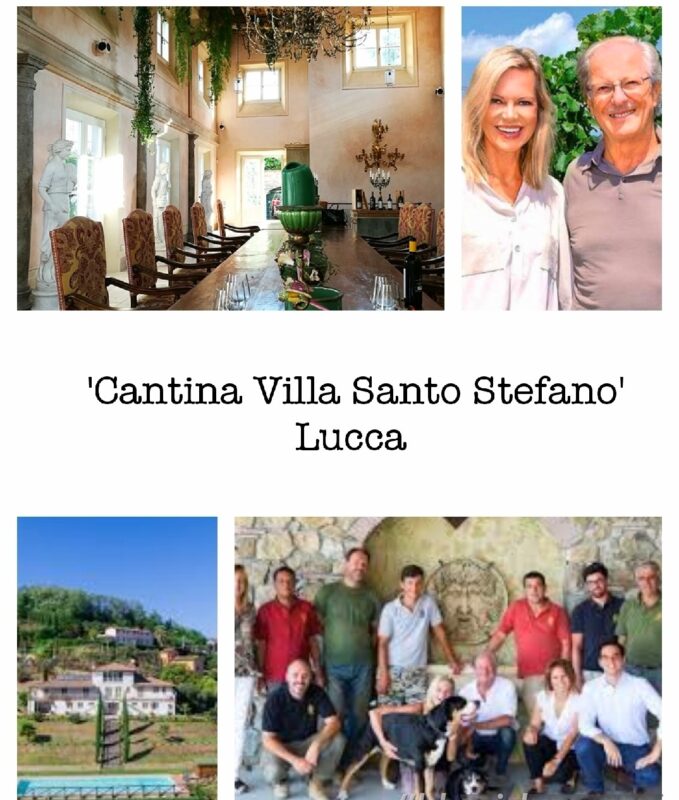
‘Cantina Villa Santo Stefano’ , uno staff eccezzioanle per dei vini speciali
Wolfgang Reitzle ci confessa che non è facile mettere in piedi un’impresa agricola come ‘Cantina Villa Santo Stefano’ di così grande di portata. Non lo aiuta il fatto di essere straniero in Italia. Perché ci sono molti problemi burocratici e logistici da risolvere. Non ultimo l’interrogativo se fare tutto ciò è da pazzi o da pionieri!
Da grande uomo di affari qual è Wolfgang Reitzle riesce nel suo intento . E dal 2005 a oggi l’avventura con ‘Cantina Villa Santo Stefano’ continua con successo . Tutto ciò grazie anche al supporto dei suoi affetti e dei suoi fidati collaboratori nelle figure di :
- Alessandro Garzi , che è il manager direzionale ;
- Alessio Farnesi , che è l’enologo;
- Antonio Spurio, che è l’agronomo ;
- Petra Pforr, che è ponsabile marketing .
Al momento ‘Cantina Villa Santo Stefano’ rileva nei suoi 11 ettari di terreno:
- Circa 30.000 bottiglie tra vino rosso e bianco (esportati per il 20% in Versilia e il restante tra Svizzera e Germania);
- 2500 litri di olio extravergine di oliva.
La filosofia che guida la ‘Cantina Villa Santo Stefano’ è la ricerca della perfezione nel fare vino ed olio sfruttando al massimo tutte le potenzialità di questo paradiso benedetto da Dio.
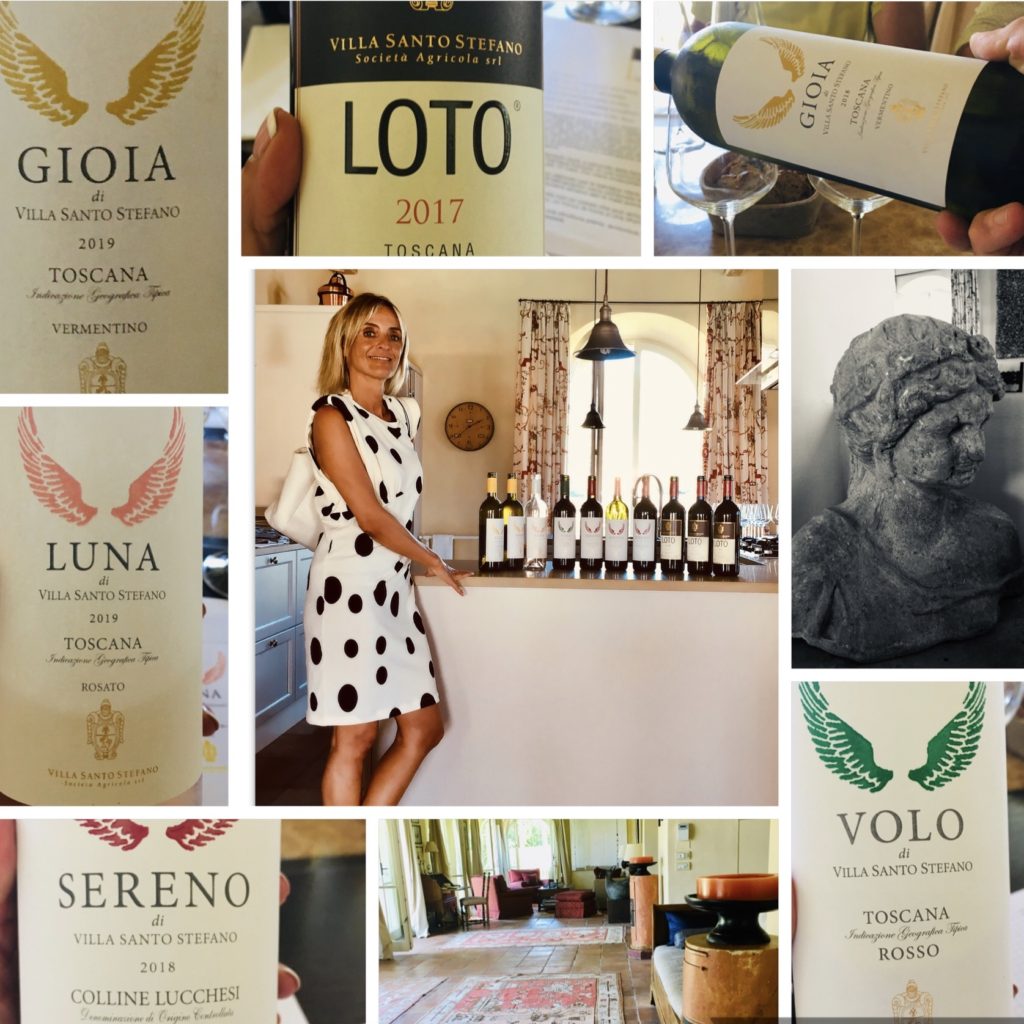
I vini di ‘ Cantina Villa Santo Stefano’
I vini di ‘Cantina Villa Santo Stefano’ sono particolari, biologici, strutturati i rossi e leggiadri i bianchi. Assaggiare un calice di vino lucchese è un’esperienza speciale. Questo ancora una volta conferma la ricchezza del patrimonio vitivinicolo della Toscana senza passare per forza attraverso nomi blasonati!
Degustazione di 5 vini
Una delle caratteristiche più distintive dei vini di ‘Cantina Villa Santo Stefano’ è la sapiente mescolanza di vitigni autoctoni con varietà di origine francese. Oltre un terroir da manuale fatto di peculiarità pedoclimatiche esclusive che sono:
- Terreni misti e prevalentemente argillosi;
- Una temperatura mite tutto l’anno;
- Ua combinazione di vicinanza al mare e montagna, che conferiscono a questi vini il loro sapore distinto.
Ecco le etichette in assaggio della ‘Cantina Villa Santo Stefano’ :
- ‘Gioia 2018 e 2019’ : è un ‘IGT Toscano’, un vino bianco fatto al 100 % di Vermentino . Questo vitigno cresce spontaneo dalla Lucchesia alla Liguria . Esso proviene da un vitigno adiacente l’azienda esposto a Sud , vicino alle spiagge della Versilia distanti circa 20 km . Qui c’è un microclima straordinario, che si riflette nell’aroma fragrante del vino stesso. La selezione e la raccolta delle uve , è eseguita scrupolosamente a mano. E dopo la diraspatura e pigiatura, le uve subiscono una leggera macerazione di qualche ora prima di essere vinificate in bianco. La fermentazione dura dai 15 ai 20 giorni e si avvale delle tecnologie più innovative. Il processo avviene infatti in vasche di acciaio a temperatura controllata tra i 15° e i 16°. Questo vino bianco, nelle due diverse annate, possiede un bouquet armonico e fruttato, una buona acidità e un tocco di mineralità che si avverte nel finale;
- ‘Luna 2019’ : fatto di 50% Merlot e 50% Sangiovese , è un rosé sobrio, che va bene su tutte le portate di mare e di carni bianche . Ed è perfetto anche per un aperitivo. Esso ha un colore rosa provenzale, al naso è pulito con profumi che ricordano la pesca bianca e la buccia di mela rossa;
- ‘Volo 2019’ : è ‘IGT Toscano‘ fatto di 40% Petit Verdot, 40% Cabernet Sauvignon e 20% Alicante. Questo è un un vino che si presenta con un colore rosso intenso e con sfumature violacee frutto della sua giovane età. Al naso è floreale, con note di prugne, more e ciliegie, con un finale delicato di cipria. Al palato si esprime frizzante, con un buon tannino ed un’ acidità equilibrata che lo fanno diventare di gradevole beva;
- ‘Sereno 2016, 2017 e 2018’ : è una ‘DOC Colline Lucchesi’ fatto da 80% di Sangiovese e 20% tra Ciliegiolo e da altri vitigni del posto. Si tratta di un vino dal colore rosso rubino con riflessi porpora, al naso note di violetta, frutti rossi e spezie. Al palato è morbido con un finale gradevole di frutta;
- ‘Loto 2015, 2017 e 2018’ : è il vino più pregiato di ‘Villa Santo Stefano’ fatto di 50% Cabernet Sauvignon, 40% Merlot e 10% Petit Verdot . Per ogni vite vengono selezionati non più di quattro grappoli, per garantire il massimo della resa da ogni pianta. Nel 2015 è stato installato un impianto computerizzato ad alta tecnologia utilizzato per garantire un processo di fermentazione e vinificazione ottimale. Di norma, il processo di fermentazione dura 12 giorni. L’affinamento dura, a seconda della tipologia di uva e dell’annata. Essa va dai 12 ai 18 mesi ed avviene in pregiate barrique francesi, in una barriccaia a temperatura (15°C) e umidità (83%) controllate. Il tipo di legno utilizzato per le barrique viene selezionato a seconda della tipologia di uva. Al termine dell’affinamento viene composta la cuvée e viene quindi imbottigliato il vino, che dovrà attendere almeno altri 6 mesi prima di essere distribuito. Questo è un vino di spessore, di corpo, che si presenta con un colore che può arrivare al rosso rubino intenso ed ha sentori di frutti di bosco, tabacco e vaniglia.
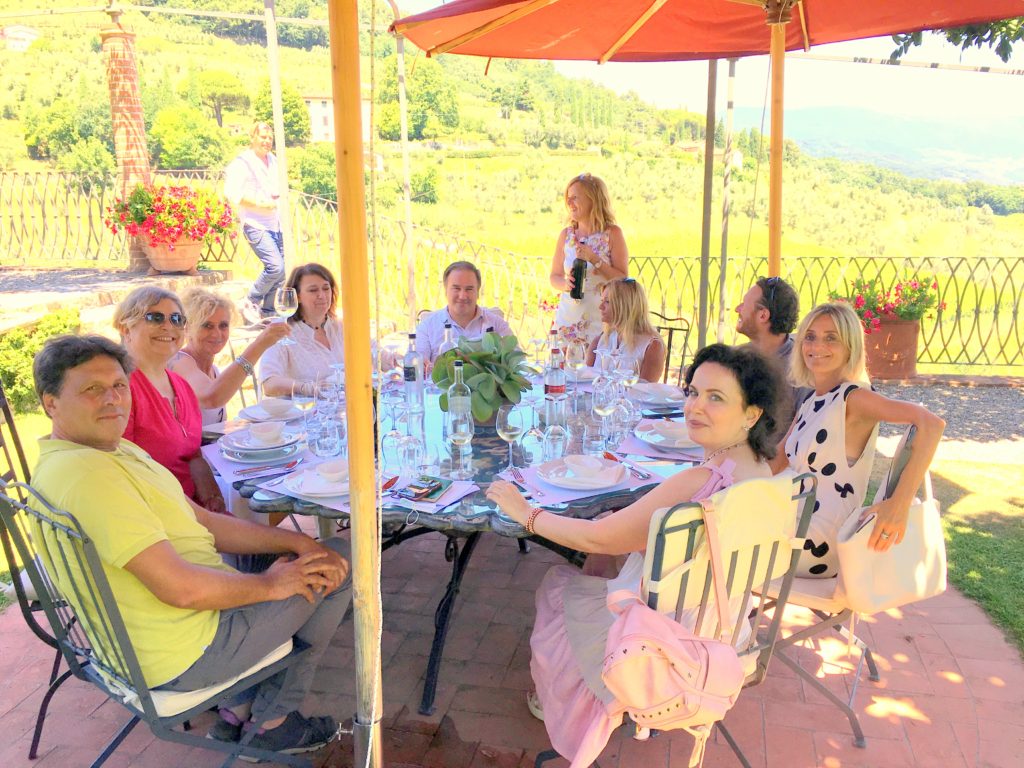
Pranzo nel giardino della ‘ Cantina Villa Santo Stefano’
Tra una chiacchiera e l’altra il tempo vola . Lo stomaco brontola percè è ora di pranzo. Nel dehors esterno della ‘Cantina Villa Santo Stefano’ tra fontane zampillanti di acqua e alberi abbracciati da boccioli di rosa iniziano il nostro lauto banchetto.
Il nostro pergolato ci protegge un po’ dalla calura estiva che finisce di darci fastidio non appena lo chef Riccardo Santini del Vignaccio ci annuncia il menù della festa:
- Una panzanella di pomodoro e cipolle all’aceto balsamico;
- Una ‘torta lunigiana d’Erbi’ di bietole spinaci e rapini;
- Uno sformato di fagiolini e formaggio di ‘Scoppolato di Pedona’;
- Faraona, zuppa di porro e patate;
- Un sorbetto al melone per pulire la bocca.
Regalatevi una fuga a ‘Cantina Villa Santo Stefano’!
‘Cantina Villa Santo Stefano’ è un borgo incantato che ti strega non appena varchi il cancello all’entrata. Vi potete perdere per ritrovarvi. Vi rilassate tra il lusso garbato e tanti vini pregiati . Questi danno il meglio riposando a lungo. Così sono pronti per essere stappati e consumati per celebrare un momento speciale.
‘Cantina Villa Santo Stefano’ con i loro vini vi dà la possibilità di scoprire la Toscana. Perchè venire? I motivi sarebbero tanti, e vanno oltre l’uva! Qui potere fare delle vacanze all’insegna dell’arte e della storia, della natura, del mare o del relax, Questa splendida regione sa offrire davvero di tutto e accontentare ogni tipo di viaggiatore: dalle città d’arte famose in tutto il mondo ai borghi medievali, dalle dolci colline del Chianti fino alle spiagge della Versilia e alle isole dell’arcipelago. Buon viaggio!
If you like my post, please subscribe to the socials of www.WeLoveitaly.eu :





